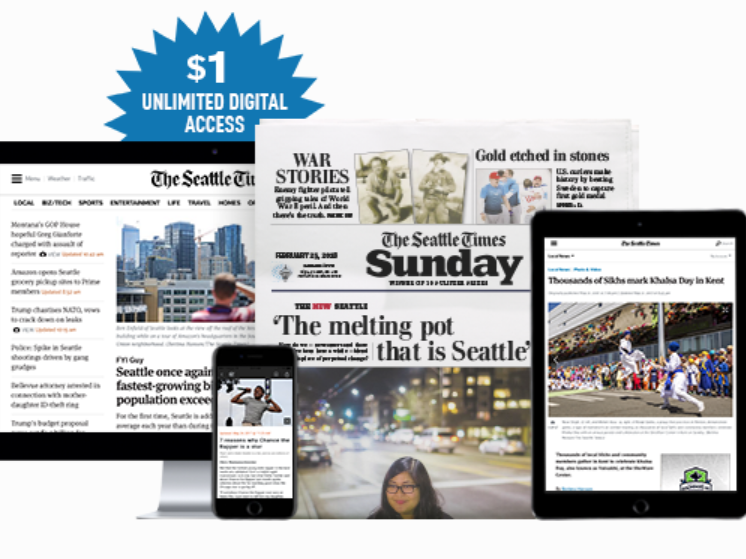
The Seattle Times now has 81,000 digital-only subscribers, establishing its position as one of America’s leading metropolitan news titles for paid online readers.
The title, independently owned by publisher Frank Blethen, has grown its digital subscriptions total by 10% – from 73,0000 – over the past 12 months. The figure has doubled in three years from 41,000 in January 2019.
In common with many other large news organisations, the Seattle Times experienced strong growth in the early months of the coronavirus crisis.
Unlike many other outlets, the publisher appears to have retained much of its growth rate through 2021.
And according to Kati Erwert, the publisher’s senior vice president of product, marketing and public service, the Times has been able to do this without discounting its subscription deals too heavily.
Click here to subscribe to Press Gazette’s must-read newsletters, Future of Media and Future of Media US |
“I think that this is one of the follies of the industry – this volume chase,” she said. “Strategically, we’ve looked at this in a very different way, where we talk about the sustainability of the size of our newsroom and the dollars that we need in terms of our long-term strategy.
“[We look at it from] a revenue standpoint, versus a ‘we are chasing this volume number’. Because there are all kinds of terrible things that you can do to your long-term viability and sustainability that will drive that volume number.
“But deep, deep, deep discounting – is that strategically the right move in order to grow those subscribers, engagement, retain them and flip them to a high price point?”
After a bumper 2020 for subscriptions growth, many large news publishers experienced slowdowns last year.
In interviews with Press Gazette, chief executives of the Atlantic and Bloomberg Media have been forced to downgrade digital subscription forecasts.
But some publishers are now taking a similar revenue-first approach to the Seattle Times.
In an interview published this week, Atlantic chief executive Nicholas Thompson told Press Gazette he does not expect to hit one million subscribers in 2022 – as previously targeted – and that his new focus is on hitting $50m in subscriber revenues this year or in 2023.
He said: “You can get to a million subs pretty easily – you can massively discount, right? If you set a goal solely on subscribers, it can move you in some harmful ways.”
Similarly, the Boston Globe said it was focused on building digital subscription revenues as volume growth faltered last year.
Curtis Huber, senior director of circulation and audience revenue at the Seattle Times, said his team has drawn much inspiration from the Boston Globe, which launched its paywall in 2011 and today has more than 220,000 digital-only subscribers.
The Seattle Times website went behind a paywall in 2013. Huber said that the Times has always viewed digital subscription revenues as a replacement for declining print sales and so has been determined to price it correctly.
“We realised that the end result was going to be digital and we needed to early on establish that our content is valuable regardless [of whether it is in print or online].
“And from that standpoint we launched digital subscriptions – understanding that it’s worth a lot of money and we’re not going to discount it. We’d much rather have a lot less subscribers and a loyal base that paid a lot.”
Huber said the Seattle Times also takes care with its introductory offers. New subscribers generally pay $1 for their first four weeks and then are moved to $4.99 a week.
This means that, after the offer period, the Seattle Times – like the Boston Globe – is on the pricier end of the digital news subscriptions market, above national titles like the New York Times and Washington Post.
Erwert believes one of the reasons the Seattle Times’ strong performance in digital subscriptions is its private ownership. “We’ve stayed small and scrappy,” she said.
Another advantage is that the Times team is focused on just one market. “We take on a lot of information from what is happening in the industry. We closely follow what our peers are doing. We talk to them regularly. And we pressure test their assumptions against our assumptions.
“Our strategic focus is a little bit different. Our market is a little bit different. Our subscribers are a little bit different in terms of the tactics that we’ve employed to acquire them.
“So we adjust and pressure test all of those assumptions against our own direction, which makes it so that there’s not quite an apples-to-apples fit because everybody is a little bit different.
“Which I think is one of the complexities for the chains. I don’t envy them in the challenge of trying to identify those winds and then peanut butter them across your entire organisation.
“I just think that that would be extraordinarily challenging because every market is so different. The kinds of content that resonates is just so different.”
Email pged@pressgazette.co.uk to point out mistakes, provide story tips or send in a letter for publication on our "Letters Page" blog
